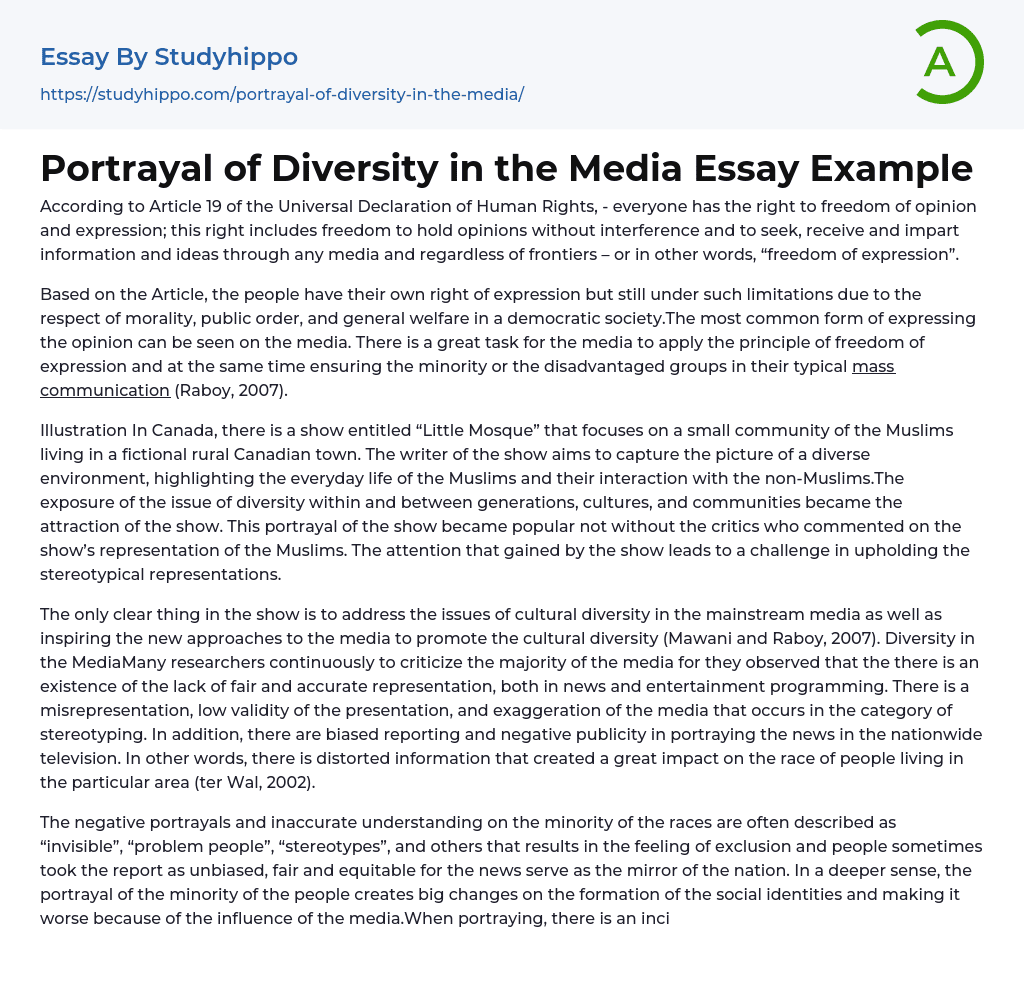According to Article 19 of the Universal Declaration of Human Rights, - everyone has the right to freedom of opinion and expression; this right includes freedom to hold opinions without interference and to seek, receive and impart information and ideas through any media and regardless of frontiers – or in other words, “freedom of expression”.
Based on the Article, the people have their own right of expression but still under such limitations due to the respect of morality, public order, and general welfare in a democratic society.The most common form of expressing the opinion can be seen on the media. There is a great task for the media to apply the principle of freedom of expression and at the same time ensuring the minority or the disadvantaged groups in their typical mass communication (Raboy, 2007).
...Illustration In Canada, there is a show entitled “Little Mosque” that focuses on a small community of the Muslims living in a fictional rural Canadian town. The writer of the show aims to capture the picture of a diverse environment, highlighting the everyday life of the Muslims and their interaction with the non-Muslims.The exposure of the issue of diversity within and between generations, cultures, and communities became the attraction of the show. This portrayal of the show became popular not without the critics who commented on the show’s representation of the Muslims. The attention that gained by the show leads to a challenge in upholding the stereotypical representations.
The only clear thing in the show is to address the issues of cultural diversity in the mainstream media as well as inspiring the new approaches to the media to promote the cultural diversit
(Mawani and Raboy, 2007). Diversity in the MediaMany researchers continuously to criticize the majority of the media for they observed that the there is an existence of the lack of fair and accurate representation, both in news and entertainment programming. There is a misrepresentation, low validity of the presentation, and exaggeration of the media that occurs in the category of stereotyping. In addition, there are biased reporting and negative publicity in portraying the news in the nationwide television. In other words, there is distorted information that created a great impact on the race of people living in the particular area (ter Wal, 2002).
The negative portrayals and inaccurate understanding on the minority of the races are often described as “invisible”, “problem people”, “stereotypes”, and others that results in the feeling of exclusion and people sometimes took the report as unbiased, fair and equitable for the news serve as the mirror of the nation. In a deeper sense, the portrayal of the minority of the people creates big changes on the formation of the social identities and making it worse because of the influence of the media.When portraying, there is an incident where the people overlook the consideration in addressing the ethno-cultural and racial background of the people. In this case, the debate for the positive and negative portrayal is high lightened.
The media has an unequivocal position in the society and their influence is beyond the people’s common knowledge, but they are not exempted in the issue of racism and diversity because they deliver the program or news not in the people expected or desirable ways.The role of the media in the society is also influenced by
some factors and the way that the media represent the idea, gives voice and focus to the different events yet, strengthens the diversity and sensitivity on ethnic groups, cultural, and religious relations in the society. There are different initiatives to promote the diversity through developing the codes of conduct, recruiting media men from the minorities, and training personnel form multiethnic societies.Through the initiatives, there is a big possibility of broadened understanding and increased awareness of the detailed information that can introduce once again the essence of cooperation and information exchange (ter Wal, 2002).
Working under Pressure In the media’s nature of work, there are positive and negative impacts on their delivery of information. Through the portrayal, the violence or enthusiasm are delivered by the actors or by a newscaster. And sometimes, they also provide the options for the people on how will they act in the natural settings (ter Wal, 2002).Through media, the victims can ask for help and the people can make certain reactions according to the information without the manipulation of the media.
The recent example would be the disaster in Haiti. Just taking the simple picture and the media can transport the picture in different form and the people can give their reaction. There is a lack of consensus on what is the real ingredient in telling that the representation or news is composed of fair and balance portrayal.The different views of the people within the cultural and racial communities are divided and leaning from that fact, there is a division on the ideas that might trigger to another argument (ter Wal, 2002).
Works Cited:
- Mawani, A., & Raboy, M. , (2007) Media Pluralism and
the Promotion of Cultural Diversity: Case Studies. Accessed 03 Feb 2010, from http://media. mcgill. ca/files/unesco_diversity. pdf
- Ageism essays
- Cultural Diversity essays
- Discrimination essays
- Diversity essays
- Gender Discrimination essays
- Multiculturalism essays
- Oppression essays
- Peer Pressure essays
- Racial Profiling essays
- Sexism essays
- Free Speech essays
- Freedom Of Speech essays
- Gettysburg Address essays
- Informative Speech essays
- Persuasive Speech essays
- Public Speaking essays
- Collaboration essays
- Dialogue essays
- Fake News essays
- Journalism essays
- Mass Media essays
- Media Analysis essays
- Media Bias essays
- Media Studies essays
- Message essays
- News essays
- Propaganda essays
- Radio essays
- Rogerian Argument essays
- Role of Media essays
- Social Media essays
- Social Media Marketing essays
- Social Networking essays
- Youtube essays




